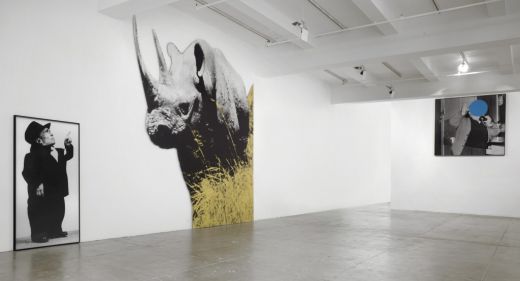John Baldessari: Installation Work 1987-1989
Jarrett Earnest

John Baldessari, Dwarf and Rhinoceros (With Large Black Shape), 1989-2013, Archival inkjet prints mounted on Lexan with inset aluminum frame, latex paint , archival inkjet print mounted on plexiglass. Courtesy of the artist and Marian Goodman Gallery, New York / Paris.
Marian Goodman Gallery, New York
By Jarrett Earnest
Alfred Hitchcock explains what a McGuffin is to Francois Truffaut with a story: It might be a Scottish name, taken from a story about two men on a train. One man says “What’s that package up there in the baggage rack?”, and the other answers, “Oh, that’s a McGuffin.” The first one asks “What’s a McGuffin?” “Well,” the other man says, “It’s an apparatus for trapping lions in the Scottish Highlands.” The first man says, “But there are no lions in the Scottish Highlands,” and the other one answers, “Well, then that’s no McGuffin!” You see, a McGuffin is nothing at all.
As Hitchcock would have it, a McGuffin is an act of misdirection, a detail that doesn’t move the story along but exists to start you down a path you’ll soon be swerved off of. One could go hunting for them in statements artists make about their work, which unfortunately get absorbed as partial facts, placing future discussions on the wrong footing. For instance, when Sol LeWitt said that in Conceptual art “the idea or concept is the most important aspect of the work,” we can call it out as a McGuffin. Of course, Lewitt was not talking about an escape from aesthetics, but an expansion of it, as when he later says: “since no form is intrinsically superior to another, the artist may use any form, from an expression of words (written or spoken) to physical reality, equally.” Artists can do whatever they want to communicate their ideas, but those decisions embody content and are thus still subject to aesthetic scrutiny. Even the performative “artlessness” of snapshots and typewriters are formal elements that transmit a message, creating the meaning of the work.
The LeWitt quotation above comes from his iconic “Sentences on Conceptual Art” (1969) that John Baldessari sang in a 1972 video. As key member of the generation that pioneered Conceptualism, Baldessari always understood that a conceptual-art idea can only be as intelligent as it is visually articulate. Idea and form are inextricably bound. His collage works from the 1960s onward explore how systems of images work like a language, how they can open onto different meanings in various combinations. In the 1980s he pushed his interrogation of image syntax into architectural space, creating installations, three of which have been remounted for the summer at Marian Goodman in New York.
In the first room, you’re immediately confronted with “Dwarf and Rhinoceros (with large black shape)” (1989-2013), a wall-size cutout of a gray rhino standing in goldenrod grass. To the left is a black-and-white photograph of an adult male dwarf in a suit and hat looking up at the rhino and pointing. Part of the joke is about scale, because although representing a dwarf, the image stands on the floor as tall an average adult viewer, who too is dwarfed by the beast. On the opposite wall is an ominous silhouette of the rhino painted in black. The lower portion of the grass is removed, making it hover with a diagonal wiggle across the bottom like a cartoon ghost. At first you don’t recognize the black blob as the rhino’s shadow—it’s not a reflection or exactly across—but once you connect their shapes a tug-of-war tension fills the room.
A similarly alternating charge is created by the other pair of walls. On one side is a photograph, its bottom even with the floor, showing a dwarf from the waist down standing on books stacked in the seat of a chair. This print is also black and white but the chair is blocked out in solid red. On the facing wall, flush with the ceiling, is the top half of this image, showing the man from the waist up talking on a phone. His face is covered with one of Baldessari’s iconic discs, beaming out of the otherwise black and white surface. There is a disjuncture between the posture in the two images that can only be resolved by realizing that one is the mirror reverse, so that even if the two halves were rejoined they couldn’t be reconciled into a unified figure. The men (it might be the same man, who can tell?) could be taken from a movie, as everything from the image quality to the model of the telephone evokes a ‘40s-film aesthetic, while the rhino might be taken from safari footage.
With works like “Dwarf and Rhinoceros,” the artist establishes different orders of images across space that never cohere into a narrative. In this, he asks deep questions about how cultural codes inhabit images and how they can be re-programmed. Baldessari’s work very often functions like a McGuffin—it provides a lot of information that you don’t actually need and then it hits you, unexpectedly, with something else. He describes it this way: “The purpose of art is to keep us permanently off balance…I like to introduce cul-de-sacs into my work that lead to dead ends because I think it is important to keep the viewer guessing.”










